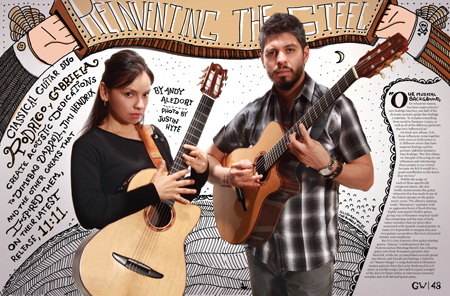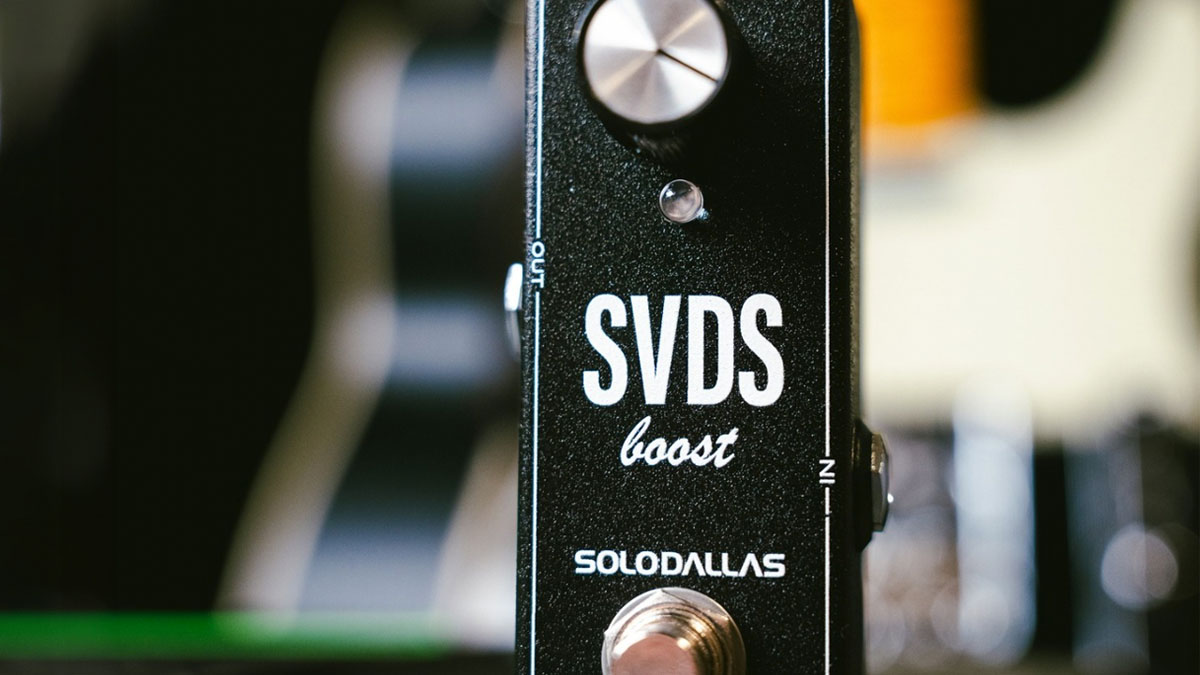Rodrigo y Gabriela: Reinventing the Steel

Originally published in Guitar World, 30th Anniversary 2010 issue
Classical guitar duo Rodrigo y Gabriela create acoustic dedications to Dimebag Darrell, Jimi Hendrix and the other greats that inspired them, on their latest release, 11:11.
"Our musical background, for whatever reason, has been super eclectic,” says Rodrigo Sanchez, one half of the dynamic acoustic guitar duo Rodrigo y Gabriela. “It includes everything from metal to flamenco to jazz, as well as all of the different guitarists that have influenced us.”
On their new album, 11:11, those influences come together with musical dedications to 11 different artists that have inspired Rodrigo and his partner, Gabriela Quintero. Says Rodrigo, “For this album, we thought of focusing on our influences and introducing these people to our crowd, because we felt it would be a good contribution to the music that we love.”
Within the scope of each of these specifically composed pieces, the duo boldly demonstrates the guitar virtuosity that has made it one of the hottest groups on the guitar music scene. The album’s opening track, “Hanuman,” explodes with an aggressive burst of hard-driving, highly syncopated rhythm guitar, giving way to flamenco-inspired rapidfire strumming and the type of dark, minor melodies that are most often associated with Spanish classical guitar. At times, it’s impossible to imagine that just two guitars can produce this level of musical density and complexity.
But 11:11 also features a few guitar-playing guests. “Atman,” a dedication to the late Pantera axman Dimebag Darrell, has a blazing guitar solo from Testament guitarist Alex Skolnick, while the accomplished acoustic guitar duo Strunz and Farrah join Rodrigo y Gabriela on “Master Maqui,” a song dedicated to flamenco master guitarist Paco De Lucia. Performed in 6/8 meter at a brisk tempo, the track is a good example of the duo’s brilliant ability to interweave intensely complex and well-defined guitar parts.
It’s something they’ve been doing together for more than 15 years. Rodrigo and Gabriela began their musical association as teenage thrash metal players in their native Mexico City. When they eventually became fed up with the underground metal scene there, they changed directions and devoted themselves to the acoustic guitar, moving to Dublin and perfoming regularly on Grafton Street and in Temple Bar. In 2004, they got a break when Irish singer/songwriter Damien Rice asked them to perform at the big Irish music festival Oxegen.
Get The Pick Newsletter
All the latest guitar news, interviews, lessons, reviews, deals and more, direct to your inbox!
The group’s first album, Rodrigo y Gabriela, was released in Ireland in February 2006, entering the Irish album charts at Number One. This breakthrough release, which has gone on to sell more than 600,000 copies worldwide, features covers of Led Zeppelin’s “Stairway to Heaven” and Metallica’s “Orion.” The duo lists Metallica among its primary influences, along with Megadeth, Slayer, Testament and Overkill.
Rodrigo and Gabriela recently stopped by the Guitar World studio to discuss their very unique approach to rock-and-metal influenced acoustic guitar music, while disclosing the idea behind their new release.
GUITAR WORLD On the new album, 11:11, every song is a dedication to a specific musician or group of musicians. How did the concept evolve?
RODRIGO SANCHEZ When we decided to do this kind of tribute album, it was based on the idea that we thought we could introduce some artists to our fans that they potentially would like but have not had access to. That way, we divert the attention from ourselves to something that is much broader in nature.
GW Have you both been playing acoustic guitar in this style since you were young?
GABRIELA QUINTERO No, not at all. We both started out playing rock music, and that was our initial exposure to learning the guitar. When we first got to know each other, we found that we were both really big fans of thrash metal. Rodrigo and I integrated that type of playing into our music, and then we started to play in a metal band. But the scene for underground metal bands in Mexico was very difficult.
So we were very frustrated, and we said, “Let’s stop the bullshit and really learn to play the guitar,” and we began to focus more on the music and to work hard to become better musicians. We would go to the beach with just our acoustic guitars, and we began to develop new music for ourselves to play based on the combination of two nylon-string guitars.
This was not the first time we began to listen to the kind of music typically played on these instruments, such as bossa nova, flamenco and classical guitar, but it was the first time we actually played these types of guitars. We had to use our ears to figure out how to get sounds from these instruments, as neither of us is classically trained—or academically trained, for that matter—at all.
GW Gabriela, a big part of the music you and Rodrigo make together is the array of percussive sounds you create with your strumming hand, filling out the sound so that it seems like much more than just two guitars. Are some of the strumming techniques you use derived from flamenco guitar?
GABRIELA It’s important to mention, especially for flamenco music lovers, that we do not play flamenco music. I spent a lot of time trying to figure out the techniques flamenco players use, but instead I went in a completely different direction and started to develop flamenco-styled rhythms.
There is, however, one technique I use that actually does have a correlation to flamenco music, which is called a rasgueado: this is similar to a standard “raking” technique inthat pick-hand fingers are dragged across the strings in rapid succession. I drag the middle and the ring fingers together, along with the thumb, across the strings in a downward motion, and then the thumb is dragged across the strings in an upward motion, creating a triplet rhythm.
I like to alternate between creating rhythms of 16th notes and 16th-note triplets with the strumming hand, and in order to do this properly I have to keep the pick-hand wrist very loose and relaxed. Once you build up a certain amount of velocity, you can use the same technique to either strum across the strings or tap rhythms on the face of the guitar.
GW On the new album, the track “Atman” is dedicated to former Pantera/Damageplan guitarist Dimebag Darrell. What led to writing this piece?
RODRIGO We are both just super fans of Dimebag and, regardless of what happened to him, we knew we were going to pay tribute to him at one time or another. His playing was very influential for us, and Dimebag was essential because he came up with so much stuff on the guitar that no one had done before. For this track, we asked Alex Skolnick from Testament to play the solo. Alex is one of our heroes, and he was very excited to play on the track because of his feelings for Dime. Alex had met Dimebag a few times, and he talked about what a sweet guy he was.
GABRIELA Since we were very young, we loved Alex’s solos on the Testament records. One of our favorite solos is the one Alex plays on the title track on the album Souls of Black. We told him we liked that specific solo and asked if he could add something like it to the track. He didn’t even remember it at all! We had to YouTube it [laughs], and he had to listen to it a few times. We also told him that we wanted some of the fucking crazy Dimebag things. I think he did an amazing solo.
GW How did you come up with the album’s title?
RODRIGO The name of the album is based on the fact that there are 11 tracks, inspired by 11 different artists.
GW But also, the title track is in a meter of 11/8.
GABRIELA Rod’s brother is the piano player on the track, and we asked him to set up a rhythm that was in some form of 11 beats.
RODRIGO We count the beats as three, three, three, two [three beats followed by three beats followed by three beats followed by two beats]. Normally when we are playing, the audience claps along, but they get into trouble with that one!
GW They will either have to know how to count it or be really drunk.
GABRIELA It’s more likely that they’ll be really drunk. [laughs]





![[from left] George Harrison with his Gretsch Country Gentleman, Norman Harris of Norman's Rare Guitars holds a gold-top Les Paul, John Fogerty with his legendary 1969 Rickenbacker](https://cdn.mos.cms.futurecdn.net/TuH3nuhn9etqjdn5sy4ntW.jpg)




